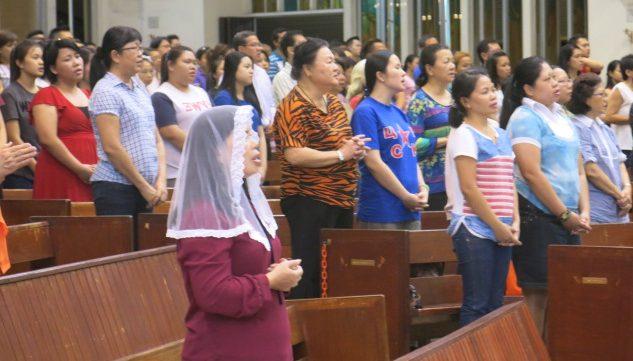Towards a Universal return to the source and summit of Christian life

Ladislaus Louis D'Souza | Guest Contributor | Radio Veritas Asia
The Church in Asia has responded well to the crisis facing the Church's pastoral ministrations amid history's most prolonged pandemic lockdown. Strictly observing government protocols, it has striven to minister to its faithful in every way possible, much of it 'online.'
The administration of the sacraments continues unabated with the distribution of Holy Communion outside Church buildings on Sundays, picking up in several parishes. Masses being live-streamed have proved to be a big draw.
Notably, the Mass celebrated by the Archbishop of Bombay, India, Cardinal Oswald Gracias, attracts participants crossing the 3000 views mark (on certain occasions, even 30,000!). In terms of singing and visual aesthetics, the orderliness of the Sunday Mass of the Franciscan Church of Saint Mary of the Angels (CSMA), Singapore, has particularly been quite a hit.
Facts undeniable – the flip side of online masses
The flip side of the online Mass is viewing Mass on TV or computer screens. Once considered, 'viewing' or 'watching' has ultimately become de rigueur in fulfilling the Sunday obligation. Indeed, that is where the faith perception of the Asian believer concerning the liturgy comes in, having, as it has, undergone a sea change.
Citing American research findings, William Grimm, Tokyo missioner, presbyter, and publisher of UCAN (Union of Catholic Asian News), in his post of August 2, 2021, writes: "Before the pandemic, more than one-quarter of Catholics who went to Sunday Mass did so out of habit...What lay behind the habit was a sense of obligation to attend… Now that people have formed a new habit of not going to Church on Sunday…, will reinstating an "obligation" be effective at helping people reactivate that old habit?... Instead of emphasizing obligation, why don't bishops emphasize opportunity? 'After more than a year and a half of being unable to come together in worship, we now have the opportunity to do so again' would be more attractive" than declaring the cancellation of the dispensation from the obligation of in-person attendance at Sunday Mass.
Remedial measures, the need of the hour
Grimm adds: "A bishop is responsible for the liturgy in the diocese…. In preparation for the reopening of churches, bishops have an opportunity to raise the quality of liturgical service. Workshops for clergy on preaching and liturgy can be done remotely while waiting for the resumption of normal activities…. If people know that the pandemic period was used to prepare an opportunity for their better return to liturgy, they will be more likely to return." Yes, 'workshops' enable our preachers to understand that repeating a given gospel passage verbatim is the poorest form of homiletics.
Future of the Church in Asia
Essentially, the Church in Asia as a whole is due for a long haul in terms of securing full attendance once churches reopen, though when that would happen is a huge question mark. Would bishops and liturgists, in the meanwhile, scrupulously oversee the removal of all the newfangled distractive liturgical anomalies discussed below? Such a process alone would strike a balance between the internal (spiritual) and external elements (aesthetics), thereby regaining the "source and summit of Christian worship" tag for the Mass, making it an enriching God experience for every believer!
1. Singing – choice of hymns and the intonations
Notably, choral singing (pre-recorded) accompanying the online Mass celebration makes for a semblance of participation. Contrarily, 'cantors' per se seem to consider it a God-sent opportunity to exhibit their fetish for casual improvisations, lyrical nuances and musical notations royally tossed, the sense of dynamics underlying hymn-compositions given short shrift. Some cantors—better referred to as 'crooners', or maybe crow-ners!—sing as if with a vengeance, the decibel of their vocal output a virtual threat to sound systems and auditory nerves alike. Others brazenly indulge in a dirge-like slow-motion murder of hymns like 'Listen' for the Entrance and 'Beginning today….' (out of place!) for Communion.
As for the sheer frivolity of 'Come and go with me to my Father's House' for the Recessional, the piece deserves to be dumped so as to nip the anything-goes attitude in the bud. Faulty intonation of 'it' as 'eat', sick as 'seek', bread & wine as 'braid-&-whine', 'Heav'nly' coolly replaced with 'Hea-ven-ly', and 'Hosanna' crudely sung freestyle, are other detestable aberrations. Pointing out liturgical truths such as 'the choir is not the queen of the liturgy but its handmaid' or that hymns ought to match the scripture readings' contents would earn you 'you're a nerd' looks.
With hardly any appealing original Church music being composed today, one cannot help but wonder whether the fate of polyphonic liturgical singing has finally been sealed by the pandemic lockdown worldwide.
2. Cantor? or ‘Co-Celebrant’?
A strange development is the usurpation of parts of the Celebrant's role by cantors who commence the recitation of the Confiteor, the Kyrie, the Gloria, Credo, Pater, Agnus. The Celebrant is busying himself with opening the page of the Missal for his next part or getting the ciboria out of the Tabernacle in readiness for the distribution of Holy Communion. That some of our younger celebrants require the assistance of their left hand to strike the breast with the right hand [Confiteor] is another amusing matter altogether.
3. Proclamation of the Word
"The Word of the Lord" has suddenly got replaced with "The Word of God"! What next, "God's Gospel"? As for the Responsorial Psalm, what does one make of liturgical norms learned in a diocesan Liturgy Course when priests, having hurried through the First Reading, say "Your response to the Psalm shall be", coolly forgetting that the Psalm essentially is the Congregation's response to God's Word just proclaimed or "Please stand up for the Acclamation," ostensibly forgetting to say "please sit down for the Gospel."
4. Dress code
The 'mini-chasuble' for Lectors in certain churches sports broad dazzling bands around the neckline, unduly drawing attention to gorgeous locks flowing down the shoulder-front. But the amusing introduction is similar garb for the Sacristan. As for those 'viewing' the Mass at home, as long as choice-driven fast-forwarding and reversing options exist, 'dress code' is a formality best ignored.
5. Altar linen
Rubrics specify the number and sizes of white sheets to be used at the Altar (the Table of Sacrifice), the longest of which, representing the burial shroud of Jesus, so placed as to have its two ends fall gracefully almost to the floor at either end, the front however remaining uncovered. Contradictorily, gaudy-coloured smocking covers the Altar-front and its sides, ugly veils wrongfully covering the beauty of carved Lecterns (the Table of the Word) and Teak-wood Altar Missal Stands. Amusingly, in certain sanctuaries, every little table is covered with Altar-cloths.
6. Floral arrangements
Floral arrangements placed on garish broad-rimmed plastic plates surmounting tree-trunk props atop wrought-iron stands just about anywhere in the sanctuary outdo themselves in size and colour scheme. Resultantly, those at the mic are seen peering through a hazy maze; their own faces largely blocked from congregational view. Often, the use of potted greenery that has obviously seen greener days and flowers that have long wilted, leaving the 'oasis' starkly exposed, constitute a needless eyesore. The most commendable in this area of the Liturgy undoubtedly is CSMA, Singapore.
7. Spiritual Communion Prayer
The Celebrant leading its recitation contradicts the fact of his consumption of the sacred species.
8. The head hair-factor of priests
Amazingly, while more women religious opt for short hair to save on hair-care time, more young priests are shedding the well-groomed look. Though there's nothing intrinsically wrong with sporting long hair, what does matter is that the unkempt look contravenes the formalness of liturgical garb, thus calling for a rethink rather than an "I couldn't care less" attitude.
9. Coax, don't taunt
With COVID-19 mutants and variants ruling the roost, full attendance even at Sunday Mass will not be easy to come by. For, innumerable are those who, depending on the severity of the C-attack and the length of recovery time, have been strictly warned by their respective physicians against even attending small "cell meets", leave alone large church gatherings. Hence, instead of taunts like, "Oh! So, you got permission from your doctor to come to receive Communion, eh?" a gentle assurance that in Church one is in a secure environment and safe hands, for the Lord does protect His own (Psalm 121:7) would be better.
Forewarned is forearmed
Frankly, unless appropriate steps are urgently taken, Grimm's assertion could well ring true: "Given the choice between un-involving in-person liturgy and moderately involving remote liturgy, people may opt for virtual participation, even if that precludes receiving the Eucharist."
Implicitly, the faith formation of the younger generation is clearly at risk. Are we willing to face the consequences of ignoring such a risk at a time when the Church in Asia is beginning to emerge as a beacon of light, its sons and daughters zealously stepping out as ministers of Salvation on the shores of the very continents whence spread the Faith?
The opinion expressed in the above write-up is about the author not necessarily of the Radio Veritas Asia.
Radio Veritas Asia (RVA), a media platform of the Catholic Church, aims to share Christ. RVA started in 1969 as a continental Catholic radio station to serve Asian countries in their respective local language, thus earning the tag “the Voice of Asian Christianity.” Responding to the emerging context, RVA embraced media platforms to connect with the global Asian audience via its 21 language websites and various social media platforms.














